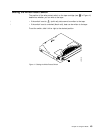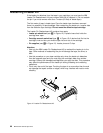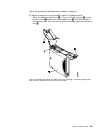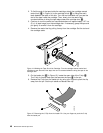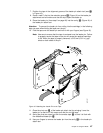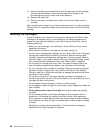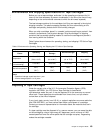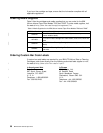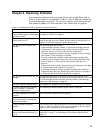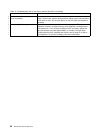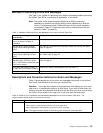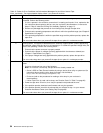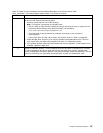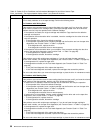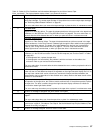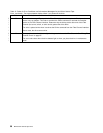
Chapter 6. Resolving Problems
If you encounter problems when running the Ultrium Internal Tape Drive, refer to
Table 10. If the problem is not identified in Table 10, refer to “Methods of Receiving
Errors and Messages” on page 53. The color and condition of the status light may
also indicate a problem. For more information, see “Status Light” on page 24.
Table 10. Troubleshooting Tips for the Ultrium Internal Tape Drive
If the problem is this.... Do this....
A code displays on the
single-character display and the status
light flashes amber.
The tape drive detected an error or is directing you to an informational
message. See Table 12 on page 53.
The status light or single-character
display never turns on.
The tape drive has no power. Check the power at the power source. Connect
power to the tape drive (see “Step 8. Connect Power to the Tape Drive” on
page 21). If the problem persists, replace the tape drive.
The tape drive will not load a tape
cartridge.
One of the following has occurred:
v A tape cartridge is already inserted. To remove the cartridge, press the
unload button. If the cartridge does not eject, turn off the power to the
tape drive, then turn it back on and press the unload button.
v The tape cartridge was inserted incorrectly. To properly insert a cartridge,
see “Inserting a Tape Cartridge” on page 26.
v The tape cartridge was defective. Insert another tape cartridge. If the
problem persists, replace the tape drive (see “Removing the SCSI Tape
Drive” on page 71 or “Removing the Fibre Channel Tape Drive” on
page 72).
v The tape drive has no power. Connect power to the tape drive (see “Step
8. Connect Power to the Tape Drive” on page 21).
v If the problem exists for multiple cartridges, the tape drive is defective.
Replace the tape drive (see “Removing the SCSI Tape Drive” on page 71
or “Removing the Fibre Channel Tape Drive” on page 72).
The tape drive will not unload the tape
cartridge.
The tape cartridge is stuck or is broken. Press the unload button. If the
cartridge does not eject, turn off the power to the tape drive, then turn it back
on. If the cartridge still does not eject, manually remove it (see “Manually
Removing a Tape Cartridge” on page 73).
The server received TapeAlert flags. See “Appendix B. TapeAlert Flags” on page 83.
The server reported SCSI problems
(such as selection or command
time-outs, or parity errors).
See “Resolving Problems Reported by the Server” on page 65.
The server reported Fibre Channel
problems.
See “Fixing Fibre Channel Errors” on page 67.
The Fibre Channel drive indicates no
Fibre Channel light, or has light but
cannot communicate.
See “Fixing Fibre Channel Errors” on page 67.
A library reported an interface
problem.
The RS-422 circuitry may be defective. Run the RS-422 wrap test (Function
Code 7 in Table 7 on page 29). If the test runs successfully but the problem
persists, refer to your library’s service documentation.
Codes display on the single-character
display, but the status light does not
turn on.
The tape drive is defective. Replace the tape drive (see “Removing the SCSI
Tape Drive” on page 71 or “Removing the Fibre Channel Tape Drive” on
page 72).
51
|
|
|
|
|
|
|
|
|
|
|
|
|



